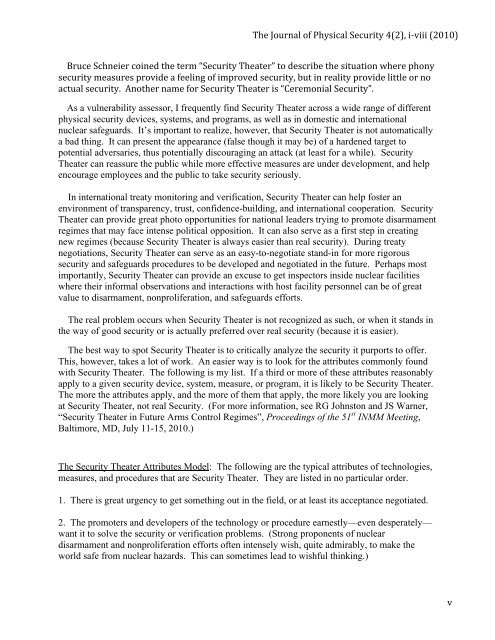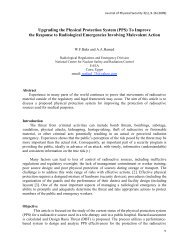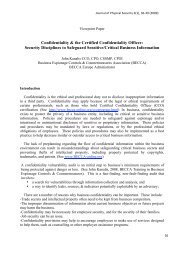PDF - The Journal of Physical Security - Argonne National Laboratory
PDF - The Journal of Physical Security - Argonne National Laboratory
PDF - The Journal of Physical Security - Argonne National Laboratory
Create successful ePaper yourself
Turn your PDF publications into a flip-book with our unique Google optimized e-Paper software.
<strong>The</strong> <strong>Journal</strong> <strong>of</strong> <strong>Physical</strong> <strong>Security</strong> 4(2), i‐viii (2010)Bruce Schneier coined the term “<strong>Security</strong> <strong>The</strong>ater” to describe the situation where phonysecurity measures provide a feeling <strong>of</strong> improved security, but in reality provide little or noactual security. Another name for <strong>Security</strong> <strong>The</strong>ater is “Ceremonial <strong>Security</strong>”.As a vulnerability assessor, I frequently find <strong>Security</strong> <strong>The</strong>ater across a wide range <strong>of</strong> differentphysical security devices, systems, and programs, as well as in domestic and internationalnuclear safeguards. It’s important to realize, however, that <strong>Security</strong> <strong>The</strong>ater is not automaticallya bad thing. It can present the appearance (false though it may be) <strong>of</strong> a hardened target topotential adversaries, thus potentially discouraging an attack (at least for a while). <strong>Security</strong><strong>The</strong>ater can reassure the public while more effective measures are under development, and helpencourage employees and the public to take security seriously.In international treaty monitoring and verification, <strong>Security</strong> <strong>The</strong>ater can help foster anenvironment <strong>of</strong> transparency, trust, confidence-building, and international cooperation. <strong>Security</strong><strong>The</strong>ater can provide great photo opportunities for national leaders trying to promote disarmamentregimes that may face intense political opposition. It can also serve as a first step in creatingnew regimes (because <strong>Security</strong> <strong>The</strong>ater is always easier than real security). During treatynegotiations, <strong>Security</strong> <strong>The</strong>ater can serve as an easy-to-negotiate stand-in for more rigoroussecurity and safeguards procedures to be developed and negotiated in the future. Perhaps mostimportantly, <strong>Security</strong> <strong>The</strong>ater can provide an excuse to get inspectors inside nuclear facilitieswhere their informal observations and interactions with host facility personnel can be <strong>of</strong> greatvalue to disarmament, nonproliferation, and safeguards efforts.<strong>The</strong> real problem occurs when <strong>Security</strong> <strong>The</strong>ater is not recognized as such, or when it stands inthe way <strong>of</strong> good security or is actually preferred over real security (because it is easier).<strong>The</strong> best way to spot <strong>Security</strong> <strong>The</strong>ater is to critically analyze the security it purports to <strong>of</strong>fer.This, however, takes a lot <strong>of</strong> work. An easier way is to look for the attributes commonly foundwith <strong>Security</strong> <strong>The</strong>ater. <strong>The</strong> following is my list. If a third or more <strong>of</strong> these attributes reasonablyapply to a given security device, system, measure, or program, it is likely to be <strong>Security</strong> <strong>The</strong>ater.<strong>The</strong> more the attributes apply, and the more <strong>of</strong> them that apply, the more likely you are lookingat <strong>Security</strong> <strong>The</strong>ater, not real <strong>Security</strong>. (For more information, see RG Johnston and JS Warner,“<strong>Security</strong> <strong>The</strong>ater in Future Arms Control Regimes”, Proceedings <strong>of</strong> the 51 st INMM Meeting,Baltimore, MD, July 11-15, 2010.)<strong>The</strong> <strong>Security</strong> <strong>The</strong>ater Attributes Model: <strong>The</strong> following are the typical attributes <strong>of</strong> technologies,measures, and procedures that are <strong>Security</strong> <strong>The</strong>ater. <strong>The</strong>y are listed in no particular order.1. <strong>The</strong>re is great urgency to get something out in the field, or at least its acceptance negotiated.2. <strong>The</strong> promoters and developers <strong>of</strong> the technology or procedure earnestly—even desperately—want it to solve the security or verification problems. (Strong proponents <strong>of</strong> nucleardisarmament and nonproliferation efforts <strong>of</strong>ten intensely wish, quite admirably, to make theworld safe from nuclear hazards. This can sometimes lead to wishful thinking.)v





